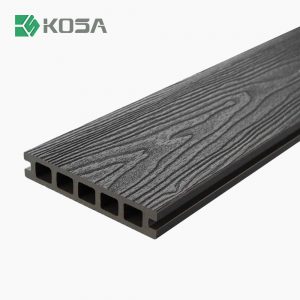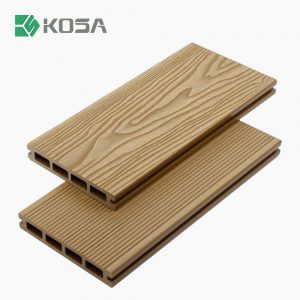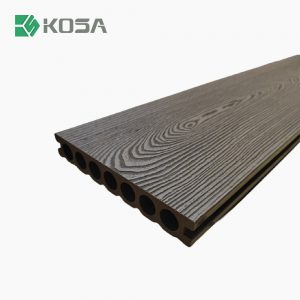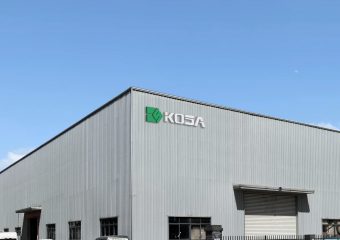Wood-plastic composite materials are a new type of composite materials that have boomed in recent years – referring to the use of polyethylene, polypropylene and polyvinyl chloride instead of usual resin adhesives, with more than 35%-70% of wood powder and rice husk , straw and other waste plant fibers are mixed into new wood materials.Finally, plates or profiles are produced through plastic processing processes such as extrusion, molding, and injection molding. Mainly used in building materials, furniture, logistics packaging and other industries. A board that is hot-extruded after mixing plastic and wood powder in a certain proportion is called an extruded wood-plastic composite board.

Characteristics of wood-plastic composite materials
The basis of wood-plastic composite materials is high-density polyethylene and wood fiber, which determines that it has certain characteristics of plastic and wood.
①.Good processing performance
②. Good strength performance
③. Water-resistant and corrosion-resistant, with long service life.
④. Excellent adjustable performance
⑤. It has UV light stability and good colorability.
⑥. Can be 100% recycled and reproduced
⑦. Wide sources of raw materials
⑧. Can be made into any shape and size
Where to use wood plastic composite materials
Outdoor: signs, structural materials, hydrophilic paving, bench strips, signs, structural materials, outdoor boards, flower box boards, decorative boards, dock paving, water passages, buildings near water, shaped (board) materials, shaped (poles) )material.
Interior: roof, floor, wall skirts, decorative moldings.
Wood plastic composite material technology
The process formula of plastic wood products can be considered as the core technology of production. The formula design method of plastic wood material is the same as that of modified plastic. It mainly refers to rationally determining the formula design based on test data and other information to meet the product performance, processing It is an important task to determine the performance and cost requirements of resins, wood/biomass fiber types and their dosage and other additives. The formula is generally designed taking into account the balance between the physical and mechanical properties, processing performance and cost of the product. Whether the formula is correct and reasonable will directly affect the processing technology and product quality of the product.
The formula of wood-plastic composite materials is usually composed of thermoplastics (new or recycled materials), wood/biomass fibers and various additives. First, raw materials and additives are selected according to the use and performance requirements of the product, and a preliminary proportioning plan is formulated according to the different molding methods and processing equipment. Then, multiple design plans are obtained through multiple experiments, and then evaluated and screened to determine the proportion of each component. proportions to complete the formula design. Before processing, put wood powder or other biomass powders, plastics and auxiliaries into a high-speed mixer according to the determined formula ratio for mixing. The main purpose is to uniformly mix several raw materials and auxiliaries, to granulate materials or various Make preliminary preparations for molding processing. Generally, during the formula design process, we mainly focus on the following aspects:
(1) Increase production speed and increase production capacity.
(2) Ensure that product performance requirements are met, such as specified physical and mechanical properties, corrosion resistance, antistatic properties and content of harmful substances, etc.
(3) Reliability and stability of the production process.
(4) Meet product appearance and surface quality.





